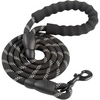One of the most common and beneficial activities you can do with your dog is walking him on a leash. However, many dog owners find themselves struggling with their pet's pulling behavior. Fortunately, with patience, consistency, and training, you can teach your dog to walk calmly on a leash.
In this article, we'll explore the steps to training your dog to walk without pulling on the leash.
Step 1: Use the Right Equipment
Choosing the right equipment is essential to successfully training your dog to walk without pulling on the leash. Opt for a chest harness or collar that won't cause your dog pain or discomfort. Choke or prong collars are not recommended as they can cause injury and are not positive training methods.
Step 2: Leash Walking Starts at Home
Start training in a quiet place at home. Put the leash on your dog without any tension, and let him get used to it. Reward him with treats and praise when he accepts the leash without resistance.
Step 3: The short walk
Once your dog is comfortable on the leash at home, go outside for a short walk. During this first outing, let your dog explore and smell his surroundings without pulling on the leash. Reward him generously every time he walks by your side without tension in the leash.
Step 4: Use Basic Commands
Teach your dog basic commands like “heel” or “loose leash.” Use these commands consistently during the walk to remind your dog what you expect of him.
Step 5: The Stopping Method
A common technique for teaching a dog not to pull on a leash is the stop method. Whenever your dog starts pulling on the leash, stop immediately. Only continue walking when the leash is relaxed. Reward your dog as soon as he stops pulling.
Step 6: Be patient and persistent
Training to walk on a leash without pulling can take time, especially if your dog has developed this behavior for a long time. Be patient and persistent, and remember to reward good behavior abundantly. Avoid physical or verbal punishment, as it is not effective and can damage the relationship with your dog.
Step 7: Distractions
Walks are often filled with distractions, such as other dogs, people, or interesting smells. Teach your dog to focus on you by using treats, toys, or praise to reward him when he follows you correctly despite distractions.
Step 8: The mental exercise
Dogs need mental exercise as well as physical exercise. Walks can be a great opportunity to exercise your dog's brain. Add obedience exercises during the walk to stimulate his mind and strengthen your connection.
Step 9: Be a Confident Leader
Dogs are naturally attracted to confident leaders. Be calm, coherent and confident during the walk. Your dog will be more likely to follow you if you emit positive, confident energy.
Step 10: Consider professional help
If your dog continues to have problems pulling on a leash despite your efforts, consider hiring a professional trainer. A dog training professional can provide you with specific techniques to resolve this problem.
Training a dog to walk without pulling on a leash requires patience
In conclusion, training to walk on a leash without pulling takes time and patience, but it is an essential skill for your dog's safety and well-being. By using the right training methods, being consistent, and rewarding good behavior, you can teach your dog to walk calmly alongside you and fully enjoy walks together.
Leash walking training is also a great opportunity to strengthen your relationship with your dog and give him a happy, balanced life.













































